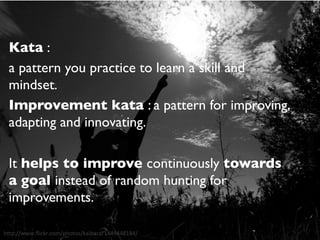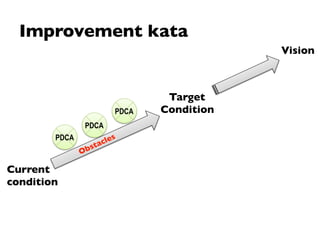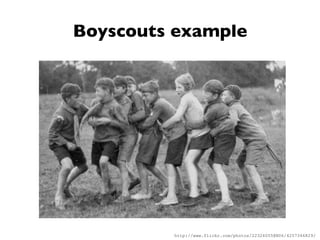The road to potential shippable increments
- 1. the ROAD to potential SHIPPABLE increments April 25, 26 - Lyon hp://www.flickr.com/photos/gravitywave/483395506/
- 2. Who am I? • Nick Oostvogels • Independent consultant • PM, agile Kanban coach • Freelance blogger • Conference organizer • Father of 3
- 4. The story • A typical Scrum team • Dedicated team of 5 devs, 2 qa, 1 PO, 1 SM, 1 analyst
- 5. The story • Switched from waterfall 6 months ago • Getting better • Being coached
- 6. The story • Developing a web application • Highly visible project • Have to start delivering
- 7. Retrospectives • Taken seriously • Improving continuously • Open minded, willing to try new things
- 8. PROJECT POST-MORTEM LESSONS LEARNED MORE FREQUENT with ITERATIVE development Agile RETROSPECTIVES Image by code_mar.al at h2p://www.flickr.com/photos/code_mar.al/4145914957/
- 9. Retrospectives SET the STAGE GATHER INFORMATION INSIGHTS DEFINE ACTIONS CLOSE
- 10. But still… Finishing a sprint 100% seemed impossible
- 17. Introducing… The 6 step program… … towards potential shippable increments hp://www.flickr.com/photos/theklan/1276710183/
- 18. 1st step Change focus by learning the improvement kata Goal: get more value out of the retrospectives
- 19. Kata : a pattern you practice to learn a skill and mindset. Improvement kata : a pattern for improving, adapting and innovating. It helps to improve continuously towards a goal instead of random hunting for improvements. hp://www.flickr.com/photos/kaibara/1449448184/
- 21. Customized for retrospectives 1. Formalize the vision “What is important for us? How do we want to deliver software?
- 24. Customized for retrospectives 2. Use the vision to agree on the target condition “What is the next step we can take to get closer to the vision?”
- 25. Customized for retrospectives 3. Use the vision as a cross-check Does this improvement suggestion help us to get closer to the vision?
- 26. Result • Better focus • Long term thinking • Systems thinking • The vision is used as a referee during discussions • It may take several sprints to get to the next target condition hp://www.flickr.com/photos/louish/5626178350/
- 27. 2nd step Focus on quality Goal:‘REALLY’ delivering features
- 28. What is quality? Zero bug policy! hp://www.flickr.com/photos/felixjacksonjr/2280660104/
- 29. How? • In sprint testing • In sprint validation Definition of done: + no open bugs related to user stories of the sprint backlog Fix regression bugs before starting new work
- 30. Results • Happier end users • Easier demo’s • Higher confidence towards deployment • More accurate planning
- 31. 3rd step Focus on improving flow Goal: identify and understand bottlenecks
- 34. • Step 1 – Find bottlenecks through symptoms • Step 2 - Plan actions to reduce or eliminate bottlenecks • Step 3 – Subordonate everything else to the above decision • Step 4 – Evaluate the bottleneck • Step 5 – go back to step1
- 35. Investigate act Walk through the lifecycle of the user stories
- 36. h2p://www.flickr.com/photos/usnavy/6083504722/ Investigate act Use measurements
- 37. Investigate act Discuss possible bottlenecks h2p://www.flickr.com/photos/smannion/3385144016/
- 38. Investigate act Plan actions to reduce or eliminate the bottleneck
- 39. Result • Awareness • Get used to hunt for bottlenecks
- 40. 4th step Make bottlenecks visible
- 41. Limit Work in Progress Active In Development (5) In Test (3) Resolved (2) Closed
- 42. Kanban board
- 43. Kanban rules Never break the WIP limits!
- 44. Being idle due to uneven flow distribution drives people crazy! hp://www.flickr.com/photos/annayanev/3491617954/
- 49. Kanban rules 1. Check if the bug list is empty 2. Check if you can help the next stage to pull a feature 3. Check if you can help somebody with a feature in your stage 4. Investigate the root cause 5. Improve the application or your way of working 6. Learn something new, related to the job What to do when the flow is stuck?
- 50. Remember: Kanban doesn’t focus on maximizing utilization of people
- 51. Result • Focus on the entire chain • WIP limits to manage flow and tackle bottlenecks
- 52. 5th step Anticipate bottlenecks early on
- 54. Distribution
- 55. SLA’s
- 56. Result • Visualisation • Better decision making • No more tasks that disappear in the process
- 57. 6th step Use SLA’s for good sprint backlog composition
- 58. Sprint backlog Big user stories need to go first We can only do a few big ones Small user stories near the end Dependent user stories may not fit the sprint S (0-‐2 sp) : 4 days -‐ 7 days M (3-‐5 sp) : 4 days -‐ 7 days L (8-‐13 sp) : 10 days -‐ 14 days
- 59. The Role of PO and SM http://www.flickr.com/photos/joshuacraig/5410326211/ Product Owner Explain priorities Actively participate Trust the team Put quality and flow first Scrum Master Guard the rules Give the team a mandate Trust the team
- 60. Compare with 1 year earlier
- 61. Compare with 1 year earlier Planning is much more accurate despite less upfront preparation • Bugfree software • Consistent delivery • Definition of done • Up to date product backlog
- 62. Compare with 1 year earlier Easier end-user testing and demos Better feedback http://www.flickr.com/photos/cblue98/7635645124/
- 63. Compare with 1 year earlier Team spirit increased http://www.flickr.com/photos/wwworks/1384952210/
- 64. Not pushing to go faster but improving end 2 end h2p://www.flickr.com/photos/rwp-‐roger/3854246685/
- 65. Compare with 1 year earlier Focus on finishing instead of starting http://www.flickr.com/photos/tharrin/3555828959/
- 66. Compare with 1 year earlier Ownership “Everybody cares” http://www.flickr.com/photos/saamiam/4203685689/
- 67. Summary 1 Improvement Kata 6 Use SLA’s during planning 2 Focus on Quality 3 Improving flow 4 Make bottlenecks visible (WIP limits) 5 Anticipate bottlenecks (SLA’s)
- 68. Available on
- 69. Related books
- 70. www.dare2013.be







































































